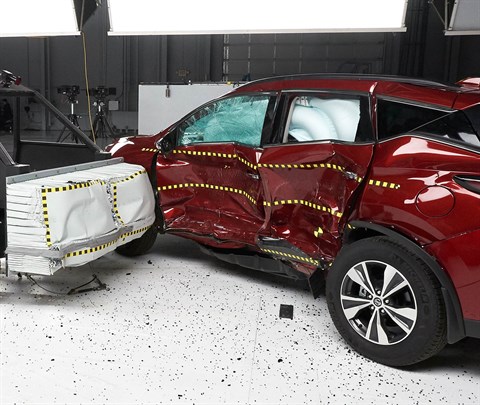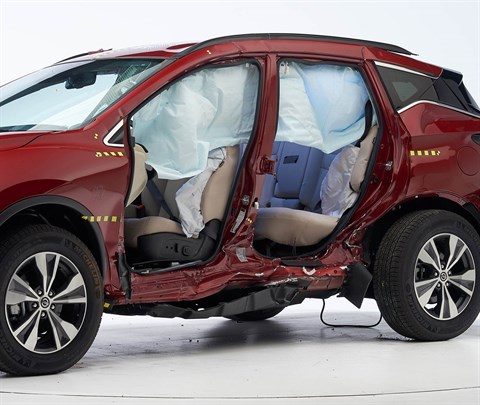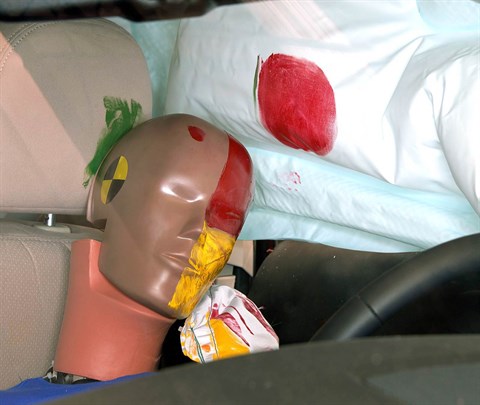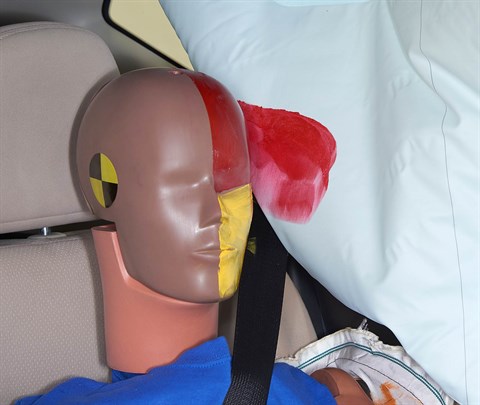Small overlap front
The small overlap front evaluation consists of a driver-side and a passenger-side component. If the results of the two evaluations differ, then the combined small overlap rating is equal to the lower rating.
Driver-side
- Rating applies to 2019-24 models
Tested vehicle: 2019 Nissan Murano SV 4-door 4wd
The Nissan Murano was redesigned for the 2015 model year. Beginning with the 2019 model year, a knee airbag for the front passenger was added, and all of the following airbags were newly designed to improve occupant protection in both moderate overlap and small overlap frontal crashes: driver knee airbag, passenger frontal airbag, and both side curtain airbags.
Driver-side small overlap frontal ratings are assigned by the Institute based on a test conducted by Nissan. Because there were no structural changes, the structure rating of the current model is based on this test and an earlier test of a 2015 model conducted by the Institute.
| Evaluation criteria | Rating |
|---|---|
| Overall driver-side evaluation | |
| Structure and safety cage | |
| Driver injury measures | |
| Head/neck | |
| Chest | |
| Hip/thigh | |
| Lower leg/foot | |
| Driver restraints and dummy kinematics | |
Passenger-side
- Rating applies to 2019-24 models
Tested vehicle: 2019 Nissan Murano SV 4-door 4wd
The Nissan Murano was redesigned for the 2015 model year. Beginning with the 2019 model year, a knee airbag for the front passenger was added, and all of the following airbags were newly designed to improve occupant protection in both moderate overlap and small overlap frontal crashes: passenger frontal airbag, driver knee airbag, and both side curtain airbags.
Passenger-side small overlap frontal ratings are assigned by the Institute based on a test conducted by Nissan.
| Evaluation criteria | Rating |
|---|---|
| Overall passenger-side evaluation | |
| Structure and safety cage | |
| Passenger injury measures | |
| Head/neck | |
| Chest | |
| Hip/thigh | |
| Lower leg/foot | |
|
Passenger restraints and dummy kinematics
The dummy’s head contacted the frontal airbag but slid off the right side, leaving the head vulnerable to contact with forward structure. The side curtain airbag deployed and has sufficient forward coverage to protect the head from contact with side structure and outside objects. | |
| Driver injury measures | |
| Head/neck | |
| Chest | |
| Hip/thigh | |
| Lower leg/foot | |
| Driver restraints and dummy kinematics | |
Moderate overlap front: original test
Rating applies to 2019-24 models
Tested vehicle: 2019 Nissan Murano SV 4-door 4wd
The Nissan Murano was redesigned for the 2015 model year. Beginning with the 2019 model year, a knee airbag for the front passenger was added, and all of the following airbags were newly designed to improve occupant protection in both moderate overlap and small overlap frontal crashes: driver knee airbag, passenger frontal airbag, and both side curtain airbags.
Moderate overlap frontal ratings are assigned by the Institute based on a test conducted by Nissan. Because there were no structural changes, the structure rating of the current model is based on this test and and an earlier test of a 2015 model also conducted by Nissan.
| Evaluation criteria | Rating |
|---|---|
| Overall evaluation | |
| Structure and safety cage | |
| Driver injury measures | |
| Head/neck | |
| Chest | |
| Leg/foot, left | |
| Leg/foot, right | |
| Driver restraints and dummy kinematics | |
Side: original test
Rating applies to 2019-24 models
Tested vehicle: 2019 Nissan Murano SL 4-door 4wd
The Nissan Murano was redesigned for the 2015 model year. Beginning with the 2019 model year, side torso airbags were added for outboard rear seat occupants, and both side curtain airbags and front-seat side torso airbags were newly designed to improve occupant protection in side impact crashes.
Side ratings are assigned by the Institute based on a test conducted by Nissan. Because there were no structural changes, the structure rating of the current model is based on this test and and an earlier test of a 2015 model also conducted by Nissan.
| Evaluation criteria | Rating |
|---|---|
| Overall evaluation | |
| Structure and safety cage | |
| Driver injury measures | |
| Head/neck | |
| Torso | |
| Pelvis/leg | |
| Driver head protection | |
| Rear passenger injury measures | |
| Head/neck | |
| Torso | |
| Pelvis/leg | |
| Rear passenger head protection | |
Side: updated test
Rating applies to 2019-24 models
Tested vehicle: 2021 Nissan Murano SV 4-door 4wd
The Nissan Murano was redesigned for the 2015 model year. Beginning with the 2019 model year, side torso airbags were added for outboard rear seat occupants, and both side curtain airbags and front-seat side torso airbags were newly designed to improve occupant protection in side impact crashes.
| Evaluation criteria | Rating |
|---|---|
| Overall evaluation | |
| Structure and safety cage | |
| Driver injury measures | |
| Head/neck | |
| Torso | |
| Pelvis | |
| Driver head protection | |
| Rear passenger injury measures | |
| Head/neck | |
| Torso | |
| Pelvis | |
| Rear passenger head protection | |

View of the vehicle just after the crash test.

View of the vehicle after the crash with doors removed, showing the side airbags and damage to the occupant compartment.

Smeared greasepaint shows where the driver dummy's head was protected from being hit by hard structures by the side airbags.

Smeared greasepaint shows where the rear passenger dummy’s head was protected by the side airbags.
Headlights
Trim level(s)
- All trims
| Evaluation criteria | Rating |
|---|---|
| Low-beam headlight type | LED reflector |
| High-beam headlight type | LED reflector |
| Curve-adaptive? | No |
| High-beam assist? | Yes |
|
Overall rating | |
| Distance at which headlights provide at least 5 lux illumination: | |
Low beams
On the straightaway, visibility was good on the left side of the road and fair on the right side. On curves, visibility was good on the sharp left and both right curves and fair on the gradual left curve.
The low beams never exceeded glare limits.
High beams
On the straightaway, visibility was good on both sides of the road. On curves, visibility was good in all 4 tests.
High-beam assist compensates for some limitations of this vehicle's low beams on the straightaway and on both left curves.
Front crash prevention: pedestrian
Child seat anchors
Rating applies to 2021-24 models
| Evaluation criteria | Rating |
|---|---|
| Overall evaluation | + extra LATCH positions |
| Vehicle trim | SV |
| Seat type | cloth |
This vehicle has 2 rear seating positions with complete child seat attachment (LATCH) hardware.
It has 1 additional seating position with a tether anchor and the ability to borrow lower anchors from the other seating positions.
Note: When anchors are borrowed, they aren't available to use in their designated positions.
| Evaluation criteria | Rating |
|---|---|
| Overall evaluation | + extra LATCH positions |
| Vehicle trim | SV |
| Seat type | cloth |
| Rating icon | Rating |
|---|---|
| G | Good |
| A | Acceptable |
| M | Marginal |
| P | Poor |
| Seating positions that rely on borrowed lower anchors or have only a tether anchor available are not rated. | |
thether anchor symbol | Tether anchor |
lower anchor symbol | Lower anchors |
| Lower anchor(s) can be borrowed from adjacent positions(s) | |
| No hardware available |
Details by seating position
| Position | Rating |
|---|---|
| 1 | |
| Tether anchor | |
| easy-to-find location | |
| no other hardware could be confused for anchor | |
| Lower anchors | |
| not too deep in seat | |
| not too much force needed to attach | |
| easy to maneuver around anchors | |
| 2 | |
| Tether anchor | |
| easy-to-find location | |
| no other hardware could be confused for anchor | |
| Lower anchors | |
| Can be borrowed from 1 and 3 | |
| 3 | |
| Tether anchor | |
| easy-to-find location | |
| no other hardware could be confused for anchor | |
| Lower anchors | |
| not too deep in seat | |
| not too much force needed to attach | |
| easy to maneuver around anchors |
